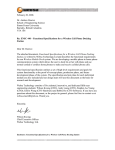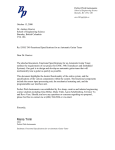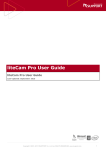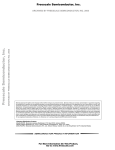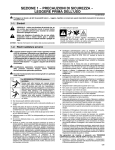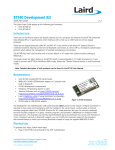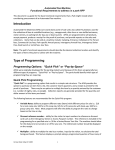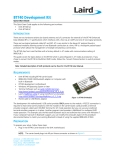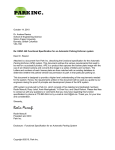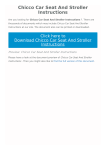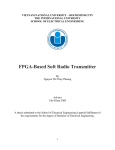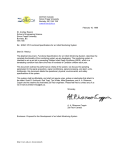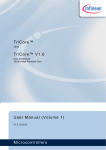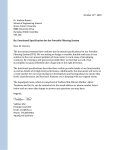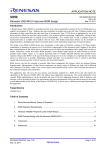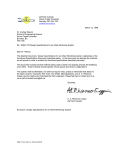Download Project Proposal for an Automatic Tracking System for Effort Saving
Transcript
Technologies Inc. [email protected] October 18, 2004 Dr. Andrew Rawicz School of Engineering Science Simon Fraser University Burnaby, BC V5A 1S6 Re: Functional Specification for a Wireless Home Phone-operated Assistant Dear Dr. Rawicz, The attached document, Functional Specification for a Wireless Home Phone-operated Assistant (HomePA), defines the various attributes of our project idea for ENSC 340. Our project is to design a phone-operated system that can control multiple home appliances and open/close doors and windows via wireless communication. This system consists of, a central control unit acting as a base transmitter, and multiple client appliance units, depending on the amount of electric devices to be controlled. The central control unit is connected to the household phone line, receiving and processing a touch-tone command sent by an individual’s phone call. The phone command determines the device to be controlled; the central control unit will then acknowledge the corresponding client appliance unit to operate the device via wireless communication. The attached document provides a functional specification of the HomePA, describes the physical, performance, interface and test requirements of each component of the project. This document also lists the specifications that will be accomplished for the deadline in December 2004. Our project team, Trax Technologies, is comprised of five enthusiastic and industrious fourth year engineering students. Group members include Sean Hou (CEO), Jack Lin (CFO) and Fred Yu (CTO), David Chen (COO), and Howard Chang (CIO). Each student brings their diverse knowledge and talents to the team. Should you have any questions regarding our project proposal, please feel free contact us at [email protected]. Yours sincerely, Howard Chang Chief Information Officer Trax Technologies Inc. Enclosure: Functional Specification for a Wireless Home Phone-operated Assistant Technologies Inc. Functional Specification for a Wireless Home Phone-operated Assistant Project Team: Howard Chang David Chen Sean Hou Jack Lin Fred Yu Contact Person: Howard Chang [email protected] Submitted to: Dr. Andrew Rawicz – ENSC 340 Mr. Mike Sjoerdsma – ENSC 305 School of Engineering Science Simon Fraser University Issued Date: October 18, 2004 Revision: 1.0 PROPRIETARY INFORMATION: Do Not Distribute Functional Specification for a Wireless Home Phone-operated Assistant Executive Summary Many people are unable to independently operate and monitor standard home appliances and equipment without the assistance. Many of these people are physically disabled suffering from paralysis, leg amputation, arthritis, and other such debilitating conditions. Though conventional home control systems are a solution, most people are unable to enjoy the comfort and efficiency that these systems provide. Most individuals cannot afford a versatile remote control system because of the excessive cost involved, along with the extensive and sophisticated installation required. Seniors and younger children may also be challenged by the complexity of familiarizing themselves with conventional system controllers. Trax Technologies is committed to developing a Wireless Home Phone-operated Assistant (HomePA), which will allow individuals to remotely control and monitor the current operating status of home appliances or open/close doors and windows via a phone call. This device will provide paraplegics, seniors, and even the general public the convenience of remotely operating and monitoring home appliances and facilities. The functional specifications describe the performance parameters, interface requirements, and physical limitations of each component of the HomePA, ensuring a smooth transition between concept and development. The HomePA is comprised of three subsystems: the central control unit, the wireless communication unit, and the client appliance unit. The central control unit will be connected to the household phone line and will receive and process a touch-tone command sent by an individual’s phone call. When an individual phones his or her own home, after a predetermined number of rings the system will automatically switch to a voice-menu interface run by the central control unit. The user will be required to enter an access code, which will lead the user to the voice menu. Here, the user can control the system through a series of touch tone commands. The control unit will acknowledge and control the corresponding client appliance unit through the wireless communication unit based on the phone command received directly through the phone line. The client appliance unit sequentially controls the designated appliance. Each subsystem has its own defined requirements in terms of its interface, system operation and physical size. These requirements represent the specifications that the finished HomePA should follow. A test plan has also been prepared to assure that our final prototype at least satisfies the various minimum requirements mentioned in this document. Copyright © 2004 Trax Technologies Inc. ii Functional Specification for a Wireless Home Phone-operated Assistant Table of Contents Executive Summary ................................................................................................................................. ii List of Figures .......................................................................................................................................... iv List of Table ............................................................................................................................................. iv Glossary ......................................................................................................................................................v 1. Introduction....................................................................................................................................... 1 1.1. Scope ............................................................................................................................................... 1 1.2. Intended Audience ....................................................................................................................... 1 1.3. Notations ........................................................................................................................................ 1 2. System Overview.............................................................................................................................. 2 3. Overall System Requirements ....................................................................................................... 3 3.1. System Power Specifications ....................................................................................................... 3 3.2. Package Specifications.................................................................................................................. 3 3.3. Environmental Specifications...................................................................................................... 4 4. Standards Compliance .................................................................................................................... 4 5. Central Control Unit ........................................................................................................................ 5 5.1. System Requirements ................................................................................................................... 5 5.2. Performance Requirements ......................................................................................................... 5 5.3. Physical Requirements ................................................................................................................. 6 5.4. Test Requirements ........................................................................................................................ 6 6. Wireless Communication Unit ...................................................................................................... 7 6.1. System Requirements ................................................................................................................... 7 6.2. Test Requirements ........................................................................................................................ 7 7. Client Appliance Unit ..................................................................................................................... 8 7.1. Performance Requirements ......................................................................................................... 8 7.2. Physical Requirements ................................................................................................................. 9 7.3. Test Requirements ...................................................................................................................... 10 8. Documentation and User Training ............................................................................................. 11 9. Conclusion ....................................................................................................................................... 12 10. Reference.......................................................................................................................................... 12 Copyright © 2004 Trax Technologies Inc. iii Functional Specification for a Wireless Home Phone-operated Assistant List of Figures Figure 1: Collaboration Diagram of Wireless HomePA ....................................................................... 2 List of Table Table 1: List of all Commands and the Corresponding Responses.................................................... 9 Table 2: List of all Queries and the Corresponding Replies ................................................................ 9 Copyright © 2004 Trax Technologies Inc. iv Functional Specification for a Wireless Home Phone-operated Assistant Glossary AC: Alternating Current ACTA: America's Carriers Telecommunication Association CCU: Central Control Unit CAU: Client Appliance Unit CSA: Canadian Standards Association CE: Consumer Electronics DC: Direct Current DTMF: Dual Tone Multi-Frequency FCC: Federal Communications Commission HomePA: Home Phone-operated Assistant IC: Integrated Circuit LED: Light Emitting Diode PCB: Printed Circuit Board PSTN: Public Switched Telephone Network RJ11: Registered Jack 11 UL: Underwriters Laboratories WCU: Wireless Communication Unit Copyright © 2004 Trax Technologies Inc. v Functional Specification for a Wireless Home Phone-operated Assistant 1. Introduction Our product, the HomePA, allows any individual to remotely control and monitor the current operating status of home appliances or open/close doors and windows with nothing more than a few touch-tone key presses via a phone call. This device will provide paraplegics, seniors, and even the general public the convenience of remotely operating and monitoring home appliances and facilities without actually having to be within physical reach of the controls. The intended completion date of our HomePA is December 2004. Upon completion, our final prototype will at least satisfy the minimum requirements required for this project. 1.1. Scope This functional specification describes in detail the various system attributes that our HomePA must satisfy by the end of our development. Three functional subsystems of the HomePA consist of the central control unit, the wireless communication unit, and the client appliance unit. The overall system requirements outline several general specifications, such as power specifications, environmental specifications, and package specifications. Since the customers of our product are targeted at diverse clientele around the world, we attach importance to ensure that our HomePA meets necessary safety and technical standards (See Compliance Standards in Section 4). In addition, for each functional subsystem, its performance requirements, physical requirements and testing requirements will be examined accordingly. Finally, a test plan is included to verify the performance and functionality of our finished prototype. 1.2. Intended Audience This functional specification is intended for both the design engineers’ and the project manager’s reference when developing the functional subsystems of our HomePA. This document will assist the design engineers in building the product according to the specified set of functional requirements. Additionally, the project manager will utilize this document to ensure the product is being developed with the required functionalities. 1.3. Notations This document will use the following notations to differentiate the minimum requirements from the ideal requirements that the functional specifications of our HomePA system must meet. Also, the notation for the various test requirements for each functional subsystem is included. M[#] I[#] T[#] This notation indicates that the specification is a minimum requirement. This notation indicates that the specification is an ideal requirement. This notation indicates the test requirement. Copyright © 2004 Trax Technologies Inc. 1 Functional Specification for a Wireless Home Phone-operated Assistant 2. System Overview The HomePA allows individuals to use any telephone to remotely control and monitor home appliances or open/close doors and windows via wireless communication. The system can be divided into three main functional subsystems: the central control unit, the wireless communication unit, and the client appliance unit(s). Notice that multiple client appliance units can coexist, depending on the number of home appliances or facilities to be controlled and monitored. The system collaboration diagram in Figure 1 illustrates how each subsystem in our HomePA interacts with each other. Home Client Appliance Unit(s) Touch-tone Command Status Report Any Telephone or Cell Phone Appliance 1 e.g. heater Central Control Unit Touch-tone User Interface . . . . . Wireless Communication Un.it Appliance 2 e.g. light Appliance N e.g. door Figure 1: Collaboration Diagram of HomePA The Central Control Unit (CCU), connected to a household phone jack, will receive incoming phone calls from a user. It possesses a touch-tone voice-menu-type user interface that allows the user to determine the home appliance or facility that he or she would like to control or monitor. The CCU will process the user’s key press(es) and then acknowledge, connect and command the corresponding client appliance via the wireless communication unit. The Wireless Communication Unit (WCU) is responsible for acknowledging the designate client appliance unit, which in turn is responsible for actually operating the designated appliance or facility. Also, in the situation that the user requests a status report from a client Copyright © 2004 Trax Technologies Inc. 2 Functional Specification for a Wireless Home Phone-operated Assistant appliance unit, the WCU forwards the result as an outgoing signal to the central control unit. The Client Appliance Unit (CAU) will be attached or integrated to an appliance or home facility that the user would like to control and monitor. Once the CAU has received a command through the WCU, it performs the assigned operation on the appliance/facility – switch on/off or open/close. The CAU can also report back to the CCU the current status of the facility or appliance via the WCU. Multiple client appliance units can be controlled by the same CCU through the wireless network. 3. Overall System Requirements 3.1. System Power Specifications The central control unit and the wireless communication unit both contain internal circuits that require connections to an external AC power supply. In addition, the motor and sensor circuits at the client appliance end draw power from rechargeable batteries. The following specifications must be met in order to ensure safe and reliable operations of the HomePA. M[01] The central control unit and the wireless communication unit must operate under 12V DC. M[02] The motor and sensor circuits used to control or monitor a client appliance unit attached or integrated to a client appliance unit or facility must be powered by 12V DC rechargeable batteries. M[03] The rechargeable batteries must sustain power for at least two weeks under normal operation. 3.2. Package Specifications Our product can be categorized into two separate packages. One package includes both the central control and wireless communication units, and the other package contains the client appliance unit. In general, both packages must meet the following requirements. M[04] The package must be relatively small in size and easy to install in all households. M[05] The package must be composed of a fixed rigid body structure in order to protect the internal circuitry of the HomePA. M[06] The package must not contain sharp edges. Copyright © 2004 Trax Technologies Inc. 3 Functional Specification for a Wireless Home Phone-operated Assistant M[07] The package must protect and insulate the internal circuits from high frequency interference and other surrounding noise disturbance. 3.3. Environmental Specifications Since our market is targeted at a diverse clientele around the world, the HomePA is expected to operate in a wide range of environmental conditions. Our product has to meet the following specifications. M[08] The product must operate under a temperature range of -20°C to 60°C. M[09] The product must operate under normal humidity. M[10] The product is guaranteed to operate under normal ambient temperate and normal atmospheric pressure. M[11] The product operation will not be affected by high frequency interference. 4. Standards Compliance The production version of our HomePA will comply with necessary operational and safety standards to ensure safe and reliable usage of the system. The following list the minimum standards our HomePA will adhere to. M[12] The packaging of all components will prevent any electrical shocks or physical injuries. M[13] The HomePA should connect to an approved PSTN. M[14] The system should be in compliance with FCC part 15 and 681, UL2, and ACTA regulations on telephone line interface and telephone terminal equipment. M[15] The motors should comply with the CE and CSA3 regulations. M[16] The wireless communication unit should comply with the FCC part 15 regulations. 1 Federal Communications Commission. <http://www.fcc.gov>. Underwriters Laboratories. <http://ulstandardsinfonet.ul.com>. 3 Canadian Standards Association. < http://csagroup.org/>. 2 Copyright © 2004 Trax Technologies Inc. 4 Functional Specification for a Wireless Home Phone-operated Assistant 5. Central Control Unit This section outlines the functions and requirements for the central control unit. 5.1. System Requirements . M[17] . M[18] The unit must receive and decode touch-tone signals via the telephone line. The unit must be able to notify users about any abrupt changes on the client appliance end, by dialling a user-preset phone number. M[19] The unit must be able to encode a user’s touch-tone command for wireless transmission. M[20] The unit must be able to receive the status from the client appliance end through the wireless communication unit. M[21] The unit must be able to send commands to a specific client appliance units. M[22] The unit must be able to withstand continual usage without a system crash. M[23] The unit must be able to display the current status of the appliances. M[24] The unit must contain a voice-menu-type touch-tone user interface. I[01] The unit shall allow end users to upgrade firmware. I[02] End users must be able to reconfigure the system according to the number of appliances to be controlled and monitored. 5.2. Performance Requirements M[25] The unit must have achieve high accuracy when decoding touch-tone signals. M[26] The unit must correctly control and monitor the corresponding home appliance or facility requested by the user. M[27] The voice-menu-type user interface requires clear informative audio messages. I[03] The unit should have a low power consumption. Copyright © 2004 Trax Technologies Inc. 5 Functional Specification for a Wireless Home Phone-operated Assistant 5.3. Physical Requirements M[28] The unit will require an external AC power supply. M[29] The unit must be compatible with the standard RJ11 telephone jack. M[30] The unit must have dimensions less than or equal to 20cm in width, 15cm in length, and 5cm in height. I[04] The unit case should grip firmly to different kinds of surfaces. I[05] The unit should be implemented on a PCB. 5.4. Test Requirements The following tests will be performed on the central control unit to ensure its reliability and functionality. T[01] Verify that the unit is able to properly decode received touch-tone signals via the telephone line. T[02] Verify that the unit is able to play the correct audio messages. T[03] Verify that the unit is able to dial to a given telephone number. T[04] Verify that the unit can properly interact with the wireless communication unit. T[05] Verify that the central control unit can operate continuously without incurring a system crash over a long period of usage. Copyright © 2004 Trax Technologies Inc. 6 Functional Specification for a Wireless Home Phone-operated Assistant 6. Wireless Communication Unit This section describes the criteria for the wireless data communication between the control and appliance units. 6.1. System Requirements M[31] The coverage of the wireless communication must be able to blanket a single house. M[32] The power consumption of the wireless transmission devices must be sufficiently low while providing reliable and accurate data transmission between the control and client appliance units. M[33] The operating frequency and signal strength must comply with Canadian regulations. M[34] Low frequency transmission should be considered for cost efficiency. M[35] The wireless communication has to ensure that it will not interfere with other existing wireless communications. M[36] The system should be resistant to interference from other external transmission sources. 6.2. Test Requirements T[06] The wireless receiver must be able to retrieve a stream of digital signals sent by the transmitter. T[07] The wireless transmitter must be able to send a stream of digital signals to the control unit. Copyright © 2004 Trax Technologies Inc. 7 Functional Specification for a Wireless Home Phone-operated Assistant 7. Client Appliance Unit This section describes the functional requirements for the client appliance units which interact with the central control unit via the wireless communication unit. In this project, we limit our controlling and monitoring applications to only four electrical appliances and facilities: doors, windows, lights and heaters/air conditioners. The requirements imposed on the electrical appliance units are broken down in the following sections. 7.1. Performance Requirements M[37] The client appliance unit must be able to receive control signals, either in the form of a query or a command, from the central control unit. M[38] The CAU must respond to a command from the central control unit. Please refer to Section 7.1.1 for command-response specifications for each type of appliance unit. M[39] The CAU must report its status, in the form of a reply signal, back to the central control unit upon receiving a query from the central control unit. Please refer to section 7.1.2 for query-reply specifications for each type of appliance unit. M[40] The CAU must store the current status of the appliance being controlled and monitored at all times. M[41] The CAU must be capable of automatically informing the central control unit when the status of the appliance is altered due to an abrupt change. M[42] The CAU must be compatible with the actual appliance or facility to be controlled or monitored. Copyright © 2004 Trax Technologies Inc. 8 Functional Specification for a Wireless Home Phone-operated Assistant 7.1.1 Requirements on Commands and Responses The following table lists all the commands that will be imposed on each client appliance unit and the corresponding response that is required from the appliance unit: Table 1: List of all Commands and the Corresponding Responses Appliance Under Control Door Window Light Heater (or Air Conditioner) Command Response Lock Lock the door Unlock Unlock the door Open Open the window Close Close the window Turn on Turn on the light Turn off Turn off the light Activate Turn on the heater Shut off Shut off the heater Increase temperature Turn up heating level Decrease temperature Turn down heating level 7.1.2 Requirements on Queries and Replies The following table lists all the queries that will be imposed on each client appliance unit and the corresponding reply that is required from the appliance unit: Table 2: List of all Queries and the Corresponding Replies Appliance Under Control Query Reply Door Is door locked? The door is locked or unlocked. Window Is window open? The window is open or closed. Light Is light on? The light is on or off. Heater Is heater on? The heater is on or off. 7.2. Physical Requirements M[43] All client appliance control units must be easy to integrate or attach directly to the actual home appliance or facility to be controlled and monitored. M[44] All CAU must be small in size relative to the actual appliances or facilities being controlled and monitored. Copyright © 2004 Trax Technologies Inc. 9 Functional Specification for a Wireless Home Phone-operated Assistant M[45] All CAU units must be light in terms of weight such that they do not introduce significant load to the actual appliances under control. M[46] All CAU must be safe to operate and electrically isolated from the user. M[47] All CAU must not degrade the performance of the original appliance. M[48] All CAU must not damage the original appliance and surrounding devices. I[06] All CAU should be aesthetically pleasing. I[07] All CAU must be implemented on PCBs. 7.3. Test Requirements To ensure the performance requirements in Section 7.1 are successfully implemented, the following testing steps must be checked for each of the four appliance control units. T[08] Verify the CAU can receive signal from the central control unit. T[09] Verify the CAU can respond to the commands. T[10] Verify the CAU can report its status when the query is received. T[11] Verify the CAU can store its current status. T[12] Verify the CAU can report a change in its status. Copyright © 2004 Trax Technologies Inc. 10 Functional Specification for a Wireless Home Phone-operated Assistant 8. Documentation and User Training Although the projected target market for our device is for the common household, the users are not expected to install the initial client appliance units. If the user requires additional client appliance units installed, a user manual will guide the user in order to make the installation process simple and straightforward. To achieve experienced use of our HomePA, the following requirements have been set for documentation and user training. M[49] A post-mortem report will be available for any potential investors. M[50] User manuals will be available to users in various languages. M[51] The intended audience of the user manual must be users with minimal experiences in electronic devices and technical knowledge. M[52] The user manual will have instructions that covers start-up, configuration, operation, troubleshooting and maintenance. M[53] The user manual will also outline the client appliance unit installation process for users intending to install additional units themselves. M[54] The manual will contain many figures and diagrams to help and instruct the user in operating or installing the device. M[55] Copyright and warranty information must be included. M[56] Contact information must be included. M[57] A company website that includes a FAQ will be available in English. M[58] The user manual and additional technical documents will be available for download via the company website. Copyright © 2004 Trax Technologies Inc. 11 Functional Specification for a Wireless Home Phone-operated Assistant 9. Conclusion The functional specifications imposed on each subsystem of the HomePA, the central control unit, the wireless communication unit, and the client appliance units, clearly define the system attributes of the product. This document outlines the functions, requirements, and standards that must be completed for the HomePA to be an effective home control device that brings convenience to elder citizens, minors, and some physically disabled people. Through these vigorous specifications, we are confident that our prototype version of the HomePA will at least satisfy the minimum requirements by our proposed completion date of December 2004. In order to ensure that all of the functional subsystems of our HomePA actually achieve their desired performance, comprehensive test plans for each component and the overall system will be carried out to reflect our thoroughly-defined requirements once the entire project is completed. Trax Technologies will also use these functional specifications as a solid blueprint for the future improvements and innovations of its HomePA. 10. Reference Digi-Key Corporation. <http://dkc1.digikey.com/ca/digihome.html>. 2004 Lamp & Appliance Timer. Intermatic Home Protection & Controls. <http://www.intermatic.com/?action=subcat&sid=113>. 2003. Microchip Technology. Products > Microcontrollers. <http://www.microchip.com/ParamChartSearch/chart.aspx?branchID=1004&mid=10&lang=e n&pageId=74>. 2004. Mobile Device Discussing Forum. A True Digital Home!. <http://www.mobile01.com/newsdetail.php?id=1350>. September 16, 2004. Copyright © 2004 Trax Technologies Inc. 12


















